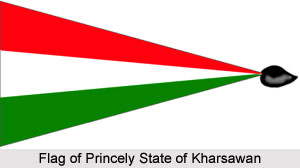 The Princely State of Kharsawan, also known as Kharsuan, was one of the princely states of India that were administered by native rulers or Indian princes under the indirect control of the British Government of India. At present Kharsawan is a notified area and a city in Seraikela Kharsawan district in the state of Jharkhand. The princely state covered a total area of 153 sq miles and comprised of a total population of 50,305 in the year 1941. Kharsawan state was located in the district of Singhbhum in Orissa. The princely state was entirely engulfed enveloped by the British Province of Bihar, excluding a border with the main block of Seraikela to the east. The Princely State of Kharsawan was incorporated as a part of the Orissa States Agency, which was a sub division of Eastern States Agency. Kharsawan state included around 263 villages in the year 1911. It was one of the Oriya speaking Princely states of India.
The Princely State of Kharsawan, also known as Kharsuan, was one of the princely states of India that were administered by native rulers or Indian princes under the indirect control of the British Government of India. At present Kharsawan is a notified area and a city in Seraikela Kharsawan district in the state of Jharkhand. The princely state covered a total area of 153 sq miles and comprised of a total population of 50,305 in the year 1941. Kharsawan state was located in the district of Singhbhum in Orissa. The princely state was entirely engulfed enveloped by the British Province of Bihar, excluding a border with the main block of Seraikela to the east. The Princely State of Kharsawan was incorporated as a part of the Orissa States Agency, which was a sub division of Eastern States Agency. Kharsawan state included around 263 villages in the year 1911. It was one of the Oriya speaking Princely states of India.
History of Princely State of Kharsawan
The territory of Kharsawan was included in the Kalinga Utkala Empire of the Gajapati Kings in Orissa. Currently the region is a part of Jharkhand and the Seraikela Kharsawan district is one of the districts. Maharaja Darbhanga visited the state as trade route to the east coast went through Singhbhum. Kumar Aditya Narayan Singh Deo and his father Maharaja Kumar Rudra Pratap Singh Deo respected the change of name of the district. During the mis-17th century, the first kunwar of Seraikela, Bikram Singh, gave the region of Kharsawan as a jagir to Padam Singh, his second son. Until the year 1818, the princely state was subordinate to Seraikela. As the native ruler of the state of Kharsawan provided loyal services to the British administration during the Sepoy mutiny in 1857, he was rewarded with 4 villages that were confiscated from the rebellious Raja of Porahat.
The Raja of Kharsawan was invested with the administrative and judicial powers, except in criminal cases, sentences of imprisonment for above 2 years required confirmation by the British commissioner. From the year 1940, a legislative council or Praja Sabha was established which included 11 members and was presided over by the native ruler of the princely state. The Princely State of Kharsawan was divided into 3 village clusters, known as pirs, after the year 1927. These were Bunkhandi, Kolhan and Sadant. Kharsawan was one of the original constituent members of the Chamber of Princes, a number of smaller states indirectly represented by 12 princes who were elected periodically by them. The native ruler of the princely state of Kharsawan was primarily a zamindar of Seraikela and his title was Thakur. Later he was raised to the hereditary rank of Raja in the year 1917.
The last native ruler of the princely state of Kharsawan acceded to the Dominion of India, also known as Union of India, after the country gained independence from the British dominion in the year 1947.



















